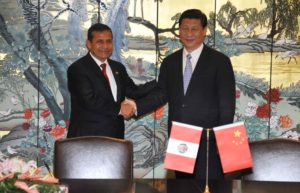Seafood has a special role in China’s luxury dining scene. Holding a big seafood banquet is a way of cementing social ties with important partners in a professional context; people in high level positions in government or the private sector often attend several banquets a week as part of their work obligations. During these banquets hosts are expected to impress their guests by serving high-status foods. Important seafood dishes often served at banquets include: lobster, giant geoduck clams, crabs and abalone, shark fin, sea cucumbers, and reef fish.
As China’s middle class expands and incomes rise, the country’s per capita consumption of seafood is increasing. Banquets typically feature exotic imported seafood. However, consumption patterns are shifting – less shark fin is being consumed following a high profile anti-cruelty campaign combined with a government crackdown on expense account dining.
Other species are moving towards the front line of endangerment, especially colourful tropical reef fish. The “live reef fish for food trade” is a major fishery industry in Asia Pacific: major source countries include Indonesia and the Philippines, and most exports go to Hong Kong and China.
Reef fish and coral at risk
Among reef fish the most lavishly priced is napoleon wrasse, which costs from 80 to 2000 yuan for 500 grams (US$130-326). Next are mouse grouper (700-1500/500grams), a delicately mottled grey and black fish, followed by scarlet leopard coral grouper, (500-1000/500gm), and other groupers.
Apart from their taste and beautiful appearance, the main attraction of these fish in Chinese seafood banquets is in fact their price: ordering them is a way of showing your guests that you value them and honour them. Fish of between 500-700gm are seen as the best quality – much bigger than that and they are viewed as losing tenderness.
Environmentalists have raised serious concerns about the impact of this fish trade on fish stocks and the health of coral reefs across Southeast Asia, and have campaigned for many years for it to be better regulated. The napoleon wrasse is endangered, several other species are threatened, and the cyanide that is often used to catch them damages coral reefs.
Apart from reef fish, tuna and salmon are popular as sushi and sashimi, prepared Japanese style, and pufferfish are also a high status dish. Generally speaking, marine fish are preferred over freshwater fish, which are viewed as common and cheap. Much seafood is cooked in the Cantonese cuisine style, a light-touch style that generally involves steaming seafood. Freshness is extremely important — in fact it is the reason behind the development of the live reef food fish trade.
Shark-fin soup is the best-known seafood dish in these banquets, internationally at least. Of the restaurant operators we interviewed, 19 out of 20 in total had sold shark fin currently or in the past. All 19 restaurant representatives reported a significant decline in the consumption of shark fin. The cruelty of harvesting shark fin has been heavily publicised in mainland China in recent years by an environmentalist campaign, using celebrity basketball player Yao Ming as an advocate. One of the things we wanted to look at in our interviews was the impact of this campaign.
Anti-corruption drive
While restaurant operators agreed that the campaign had definitely raised awareness of the shark fin issue among consumers, their views were mixed on how much impact it had had on actual consumption. Anxiety over the preponderance of fake or synthetic shark fins on the market was cited by many as a more important reason for the decline. Synthetic shark fin is common, denting consumer confidence. Trust in the food system more broadly in China is extremely low, as it has been hit by multiple food safety scandals and crimes in recent years.
In recent years there have also been significant policy developments that have had a big impact on luxury seafood consumption. When President Xi Jinping’s administration came into office, it launched a widespread crackdown against all forms of government excess, and government banquets were one of the main targets. Specifically, the government announced a ban on shark fin at state banquets within three years, or by 2015. The crackdown has had a significant effect on luxury seafood demand in China, and while it is difficult to distinguish what the overall effect is, there have been many reports that many that luxury seafood restaurants have been struggling in recent times. In the past few years, it is this anti-corruption campaign, more than anything else, which is likely to have had most impact on shark fin consumption.
The way ahead
Any successful comprehensive environmental strategy for addressing luxury seafood consumption in China will likely need to take a pragmatic approach that deals with both markets and improved regulation. Some existing initiatives include: calls for greater forms of traceability within the Chinese seafood market; the adoption of certification schemes such as those promoted by the Marine Stewardship Council; the use of the Convention on International Trade in Endangered Species of Wild Fauna and Flora (CITES) as a conservation tool for endangered species consumed in China; and the development of consumer awareness campaigns, one notable example being the one on shark fin consumption.
Our research emphasised understanding the role of consumer perspectives. Increased public awareness of environmental issues among consumers will likely be one driver of reduced consumption of unsustainably sourced seafood in Chinese banquets. However, other than the shark fin campaign, we found very little awareness of or interest in sustainability issues among traders, consumers and restaurant managers.
Possible campaign issues
Customers, managers and chefs typically know very little about any of the issues surrounding live reef food fish for example – very few know where they are caught; and none had heard about the use of cyanide to catch the fish. Some were convinced that their coral trout was imported from the US, others that their napoleon wrasse came from Australia, neither of which was true. Very few people know much beyond the next link in the market supply chain, meaning they only know their direct seller or buyer. These dominant perceptions suggest considerable room for increased education and awareness campaigns about seafood sustainability and traceability.
However, our research also suggests that campaigns could also focus on issues that currently concern consumers most, such as personal health and food safety. The importance of food safety worries in consumer consciousness in China is difficult to overstate, given the depressingly-regular food scandals hitting the headlines. Endangered live reef food fish such as napoleon wrasse, for example, have a host of issues that campaigners could potentially focus on. Cyanide remains a common fishing technique. High quantities of antibiotics and tranquilisers are also given during their long journeys to mainland China. If consumers were more aware of such health issues they may be less willing to eat the fish.
Our research also demonstrated how luxury seafood consumption is closely tied to social networking and rent‑seeking behaviour by business and government officials. In addition to specific policy actions relating to luxury seafood consumption, therefore, broader efforts to reduce corruption that do not focus on the resource itself may prove just as relevant. How successful they are over the long term remains to be seen.
Dr Michael Fabinyi is the Society in Science – Branco Weiss Fellow at the Australian Research Council Centre of Excellence for Coral Reef Studies at James Cook University. This article is based on research published together with Liu Neng in Conservation and Society, provides an overview of seafood banquets in Beijing and the factors that are changing them.








